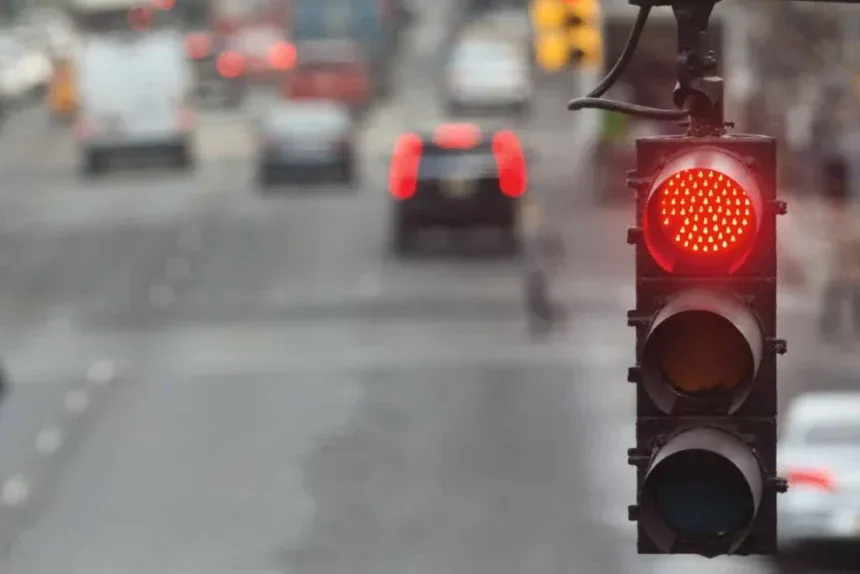Traffic laws can vary significantly across states, with updates and modifications introduced regularly to enhance road safety and efficiency. In 2024, Alabama introduced updates to several traffic regulations, most notably concerning the “Right Turn on Red” rule. This guide provides an in-depth look into Alabama’s updated traffic rules, focusing on the changes to the right turn on red law, its implications for drivers, and how cities across Alabama are implementing these changes.
The “Right Turn on Red” rule allows vehicles to make a right-hand turn at a red traffic signal after coming to a complete stop, provided there is no sign explicitly prohibiting the action. This rule is widely practiced across the United States and is designed to help improve traffic flow, reduce congestion, and decrease wait times at intersections.
Alabama, like most states, had previously allowed right turns on red under specific conditions. However, the 2024 update to the traffic regulations includes more detailed provisions and restrictions on when and where drivers can execute these turns. The new rules aim to increase safety, particularly in high-traffic urban areas and intersections that see significant pedestrian and cyclist activity.
History and Purpose of the Rule
This Article Includes [hide]
- 1 History and Purpose of the Rule
- 2 Alabama’s 2024 Right Turn on Red Update: Key Changes
- 3 Cities Implementing the 2024 Right Turn on Red Rule
- 4 Safety Concerns and Rationale Behind the Update
- 5 6. Impact on Pedestrians and Cyclists
- 6 What Drivers Need to Know: Guidelines for Safe Turning
- 7 Penalties for Violating the Right Turn on Red Rule
- 8 Comparing Alabama’s Rules with Other States
- 9 Public Reaction and Future Implications
- 10 Conclusion
The right turn on red rule originated in the 1970s as part of a nationwide effort to conserve fuel during the energy crisis. By allowing vehicles to turn right at red lights (after stopping), drivers could avoid unnecessary idling, saving fuel and reducing emissions. Over time, the rule became standard across the U.S., with individual states adapting it based on local conditions and safety concerns.
In Alabama, the rule has been part of the state’s traffic code for decades, with the general understanding that drivers could make a right turn on red after coming to a full stop and ensuring the intersection was clear of traffic, pedestrians, and cyclists. The 2024 update marks a significant shift in how this rule is applied, introducing new restrictions aimed at improving safety.
Alabama’s 2024 Right Turn on Red Update: Key Changes
Statewide Changes
The 2024 traffic update in Alabama brought several changes to the right turn on red rule, particularly focusing on high-risk intersections. The most notable changes include:
- Designated No-Turn Zones: Specific intersections across the state are now marked as no-right-turn-on-red zones. These zones are primarily located in areas with heavy pedestrian traffic, such as near schools, hospitals, and downtown districts.
- Longer Wait Times for Turns: In some areas, drivers are required to wait for a green arrow to make a right turn, even if the red light is otherwise clear of traffic. This change is designed to reduce the risk of accidents in complex intersections.
- Improved Signage: The Alabama Department of Transportation (ALDOT) has installed clearer signage at intersections where the right turn on red is either restricted or prohibited. This includes more visible “No Turn on Red” signs and electronic signals indicating when a turn is permitted.
- Pedestrian and Cyclist Prioritization: In line with broader national trends, Alabama has updated its right turn on red rules to give greater priority to pedestrians and cyclists. Drivers are now required to give right of way to anyone in a crosswalk before making a right turn on red.
City-Specific Implementation
Different cities across Alabama have adapted these changes based on local needs. Urban centers like Birmingham and Montgomery have seen more extensive restrictions, while rural areas have experienced fewer modifications.
Cities Implementing the 2024 Right Turn on Red Rule
Birmingham
As Alabama’s largest city, Birmingham has been at the forefront of implementing the new right turn on red rules. The city has designated multiple intersections as no-turn zones, particularly in the downtown area, where pedestrian activity is highest. In 2023 alone, the city recorded over 150 pedestrian-related accidents, which motivated local officials to prioritize safety in the 2024 update.
Major intersections along streets like 20th Street North and 5th Avenue South have seen new signage and restrictions. These changes are intended to improve safety for pedestrians walking near attractions like the Birmingham Museum of Art and the Alabama Theatre.
Montgomery
Montgomery has taken a similar approach, with a focus on intersections near schools and parks. For example, intersections around Alabama State University and Riverfront Park have been marked as no-right-turn-on-red zones to protect students and visitors. The city’s urban layout and tourist attractions make it crucial to ensure traffic moves efficiently while keeping vulnerable road users safe.
Mobile
Mobile’s port city infrastructure presents unique challenges. In high-traffic areas like Dauphin Street and Government Boulevard, the city has installed new signals and signage to guide drivers. Mobile has seen a rise in cycling as a mode of transportation, which further justifies the stricter enforcement of the right turn on red rules in busy downtown districts.
Huntsville
As a growing tech hub, Huntsville has a rapidly expanding urban area. Intersections near Redstone Arsenal and Bridge Street Town Centre have seen changes to the right turn on red rule. With many new developments and increasing traffic congestion, Huntsville officials believe these changes will improve traffic flow and safety.
Tuscaloosa
Home to the University of Alabama, Tuscaloosa experiences significant pedestrian traffic, especially during sporting events and school hours. In response to student concerns, the city has restricted right turns on red near campus buildings and popular areas like Bryant-Denny Stadium. These changes aim to reduce vehicle-pedestrian collisions and improve overall road safety.
Safety Concerns and Rationale Behind the Update
The primary motivation behind Alabama’s 2024 update is the growing concern for pedestrian and cyclist safety. According to ALDOT, Alabama recorded over 7,000 pedestrian-related accidents between 2019 and 2023, many of which occurred at intersections where vehicles were making right turns. This alarming statistic prompted lawmakers to take a closer look at how right turns on red were contributing to accidents.
The new rule modifications are also in line with national safety initiatives aimed at reducing traffic fatalities. The National Highway Traffic Safety Administration (NHTSA) has recommended that states re-evaluate their right turn on red policies in light of increasing urban traffic and pedestrian activity.
6. Impact on Pedestrians and Cyclists
Pedestrians and cyclists are the most vulnerable road users, particularly in urban settings. The 2024 traffic rule update in Alabama places a strong emphasis on protecting these groups by ensuring that drivers are more aware of their presence at intersections. The new rule requires drivers to come to a full stop and wait for pedestrians and cyclists to clear the intersection before turning, even if the light is red.
According to a study conducted by the University of Alabama, nearly 35% of pedestrian-related accidents in Tuscaloosa involved vehicles making right turns on red. The updated rule aims to significantly reduce this percentage by enforcing stricter guidelines and ensuring drivers are more cautious.
What Drivers Need to Know: Guidelines for Safe Turning
With the changes in place, drivers in Alabama should be aware of the following guidelines:
- Always Come to a Full Stop: Even if there is no traffic, you must come to a complete stop at a red light before making a right turn.
- Check for Signs: Look for “No Turn on Red” signs, which will indicate whether or not a right turn is allowed at the intersection.
- Yield to Pedestrians and Cyclists: Before turning, always check for pedestrians in crosswalks and cyclists in bike lanes. If anyone is crossing, you must wait for them to clear the intersection.
- Look for the Green Arrow: In some areas, you will need to wait for a green arrow before making a right turn, even if the red light is otherwise clear of traffic.
Penalties for Violating the Right Turn on Red Rule
Violating the new right turn on red rule can result in fines and points on your driving record. The standard fine for failing to stop before turning is around $100, with additional court fees. More serious violations, such as causing an accident while turning, can lead to higher fines, loss of driving privileges, or even criminal charges.
Repeat offenders may face penalties of up to $500 and additional points on their licenses. Accumulating too many points can result in suspension of driving privileges under Alabama’s traffic law.
Comparing Alabama’s Rules with Other States
Alabama’s 2024 update mirrors changes seen in other states. For example, California and New York have already implemented stricter right turn on red rules in high-traffic urban areas. States like Florida and Texas also have designated no-turn zones similar to those introduced in Alabama.
Public Reaction and Future Implications
The response to Alabama’s updated right turn on red rules has been mixed. Many residents, particularly pedestrians and cyclists, have welcomed the changes, noting that they feel safer crossing intersections. However, some drivers have expressed frustration with the increased restrictions, especially in congested areas where traffic delays are common.
As Alabama continues to grow, these changes may evolve further. Cities are expected to monitor the impact of the 2024 update and adjust policies as necessary to balance traffic flow with road safety.
Conclusion
Alabama’s 2024 traffic rule update represents a significant step toward improving road safety, particularly for pedestrians and cyclists. By revising the right turn on red rule and implementing stricter guidelines, the state aims to reduce accidents and create safer intersections for everyone. Drivers must familiarize themselves with these changes and exercise greater caution when making right turns at red lights to ensure compliance and contribute to safer roads.







Leave a Reply